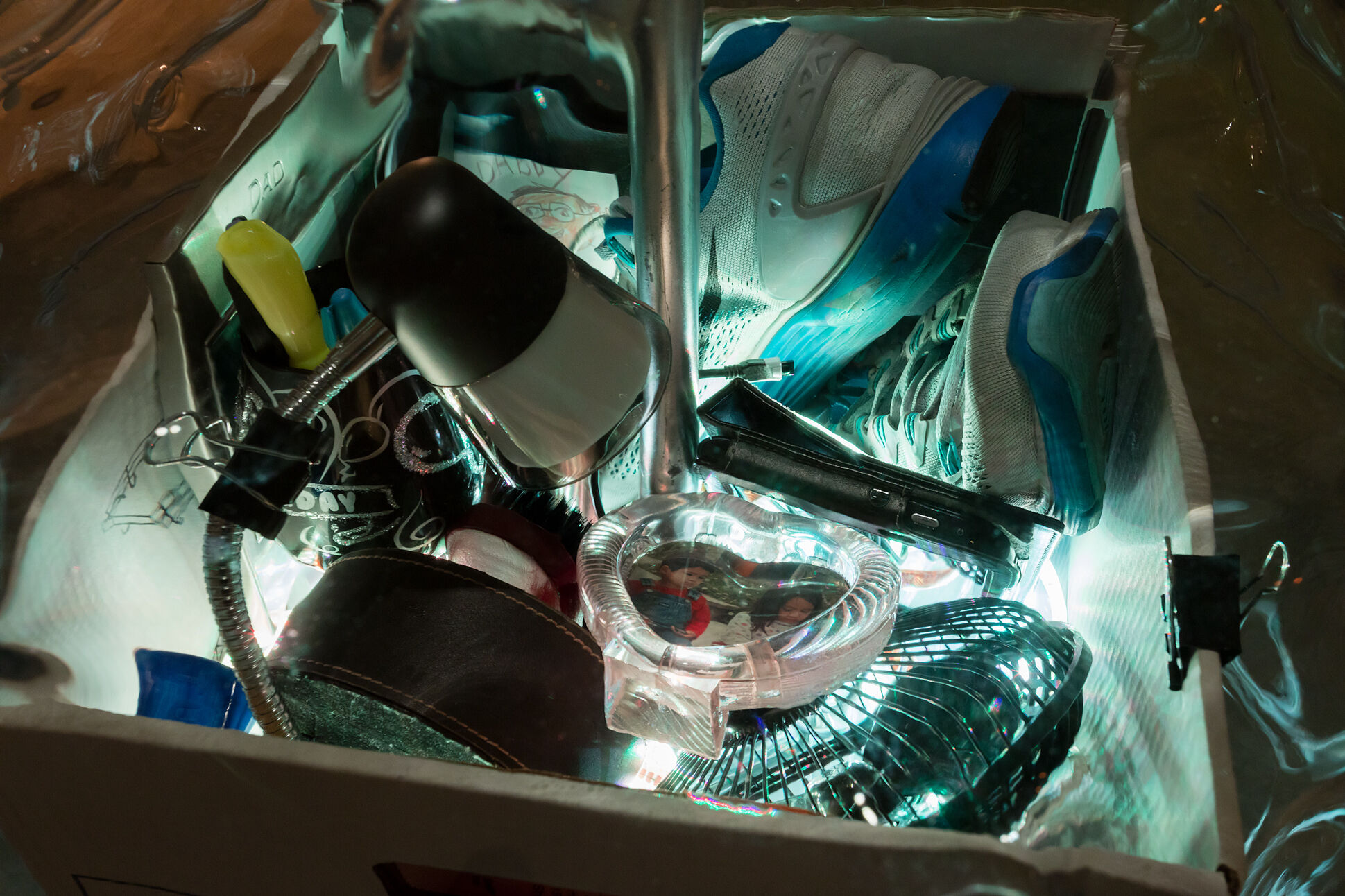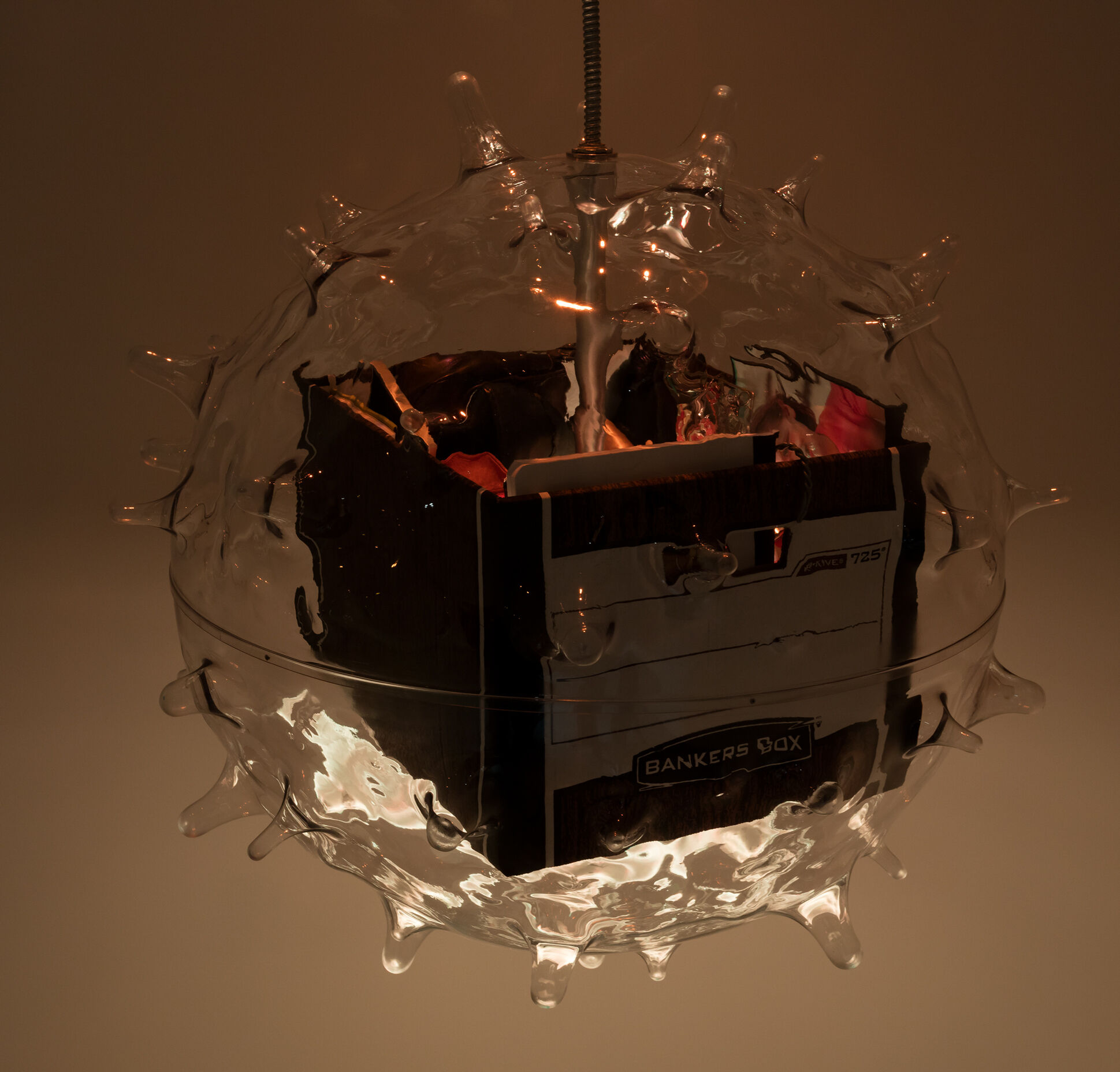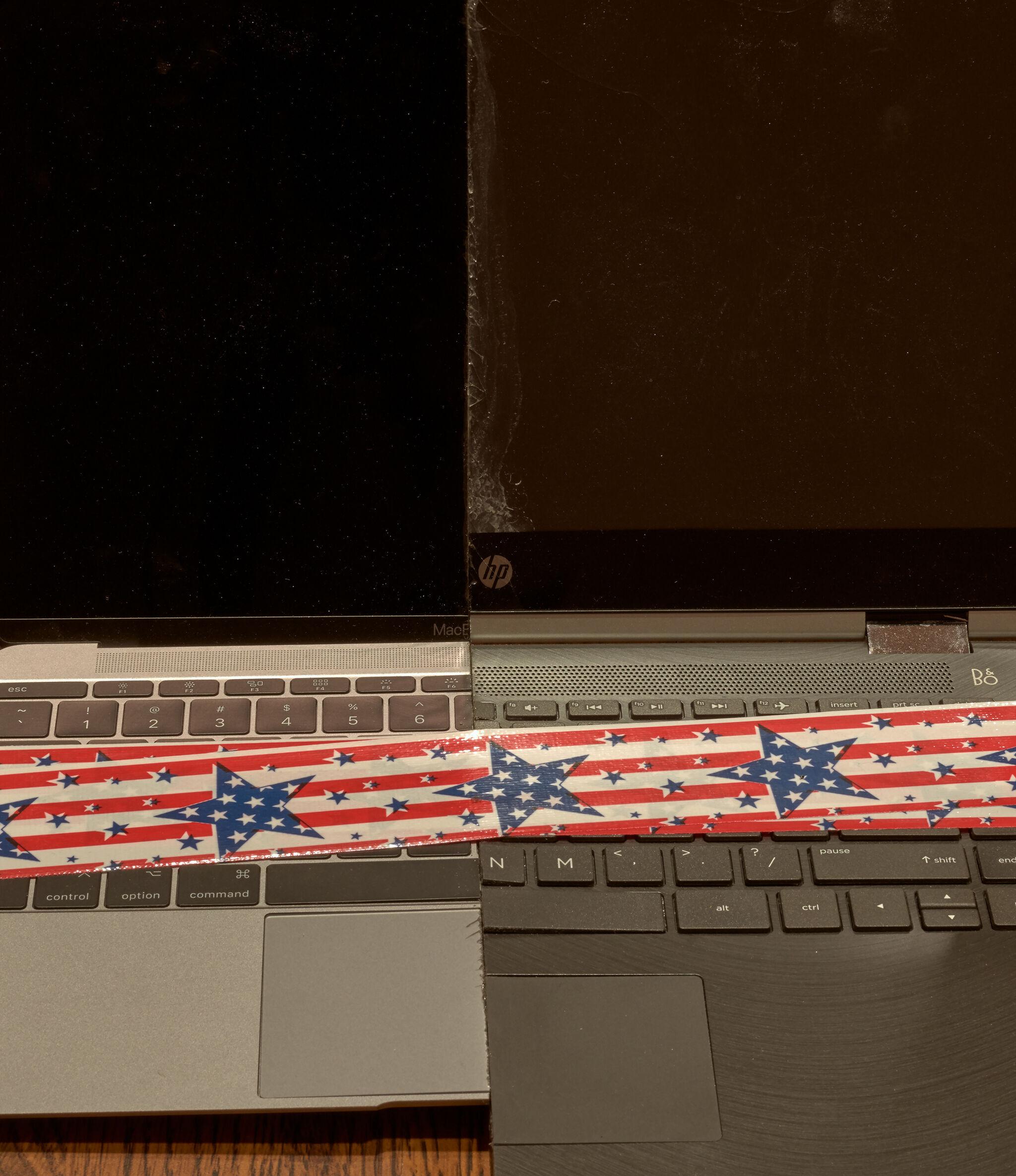Our Brand Is Crisis
Christopher Y. Lew, former Nancy and Fred Poses Curator at the Whitney and current Chief Artistic Director at the Horizon Art Foundation and Outland Art
Related exhibition
The exhibition Josh Kline: Project for a New American Century is on view April 19–August 13, 2023.
It is the sense of mid-level white-collar anguish, frustration, and existential crisis that the American artist Josh Kline captures in such a deadpan manner in his 2016 sculptural works titled Contagious Unemployment. Here, six cardboard file boxes illuminated from within form dramatic bright spots in a darkened room, each of them filled with the accoutrements of office life—an extra pair of heels, a framed vacation photo, a child’s drawing. Yet that sense of intimacy is arrested by what envelops each box: a giant-size virus made of clear plastic. The viruses are menacing, adorned with spike proteins that extend out from a central sphere, threatening to penetrate the nearest body. Serving as a vehicle and container for the physical manifestation of unemployment, the form suggests contradictory relationships between itself and its cargo: Is it the virus that is infecting society with unemployment? Is unemployment—and I would venture to include its antithesis, work—the virus itself? Or is the notion of work as a foundational aspect of one’s identity the virulent plague? Is it corporate life and the always-on economy? Like actual viruses, the unemployment virus packs great potency into a small capsule.
Completed in spring 2016, more than three years before the COVID-19 pandemic, the Contagious Unemployment sculptures, like so many of Kline’s other works, anticipate a disaster that is about to strike the United States—only in this case, the prophecy is coincidental (though not purely so, of course, since the years leading up to the show had seen outbreaks of SARS, MERS, and Ebola, not to mention the continuing pandemic of AIDS). The COVID-19 pandemic has exacerbated the weaknesses in American society, which are many and heartbreaking. To name just a few: systemic racial violence, economic inequality, underinvestment in health care and infrastructure, and the lack of support for and protection of workers of all types.
The intended target of the Contagious Unemployment works is how automation is rendering workers obsolete; in light of the pandemic, that sense of precarity surrounding labor has only been amplified, generating a deep reevaluation of work and its meaning. While COVID-19 has proven deadly and devastating for millions—and its full repercussions will take years to comprehend—it has also engendered a burgeoning workers’ movement that has the potential to wrest power from management, after its having lost ground to employers relentlessly over the last fifty years.
In 2015, Kline exhibited the first of an ongoing cycle of installations grappling with the social consequences and human fallout of current and oncoming technological changes, political conflict, and ecological devastation. Each “chapter” of the cycle envisions a different scenario set in the coming decades of the twenty-first century. His 2016 installation Unemployment is the second chapter in the cycle. Consisting of a multiroom installation that includes his Contagious Unemployment virus sculptures, the work is situated in an imagined 2030s or 2040s, a time when automation has replaced white-collar workers like accountants, administrators, and lawyers. Like the robots that entered the factory floor in the late twentieth century, dramatically reducing the number of industrial workers, Kline anticipates a scenario in which artificial intelligence and related technologies also take over many desk jobs.
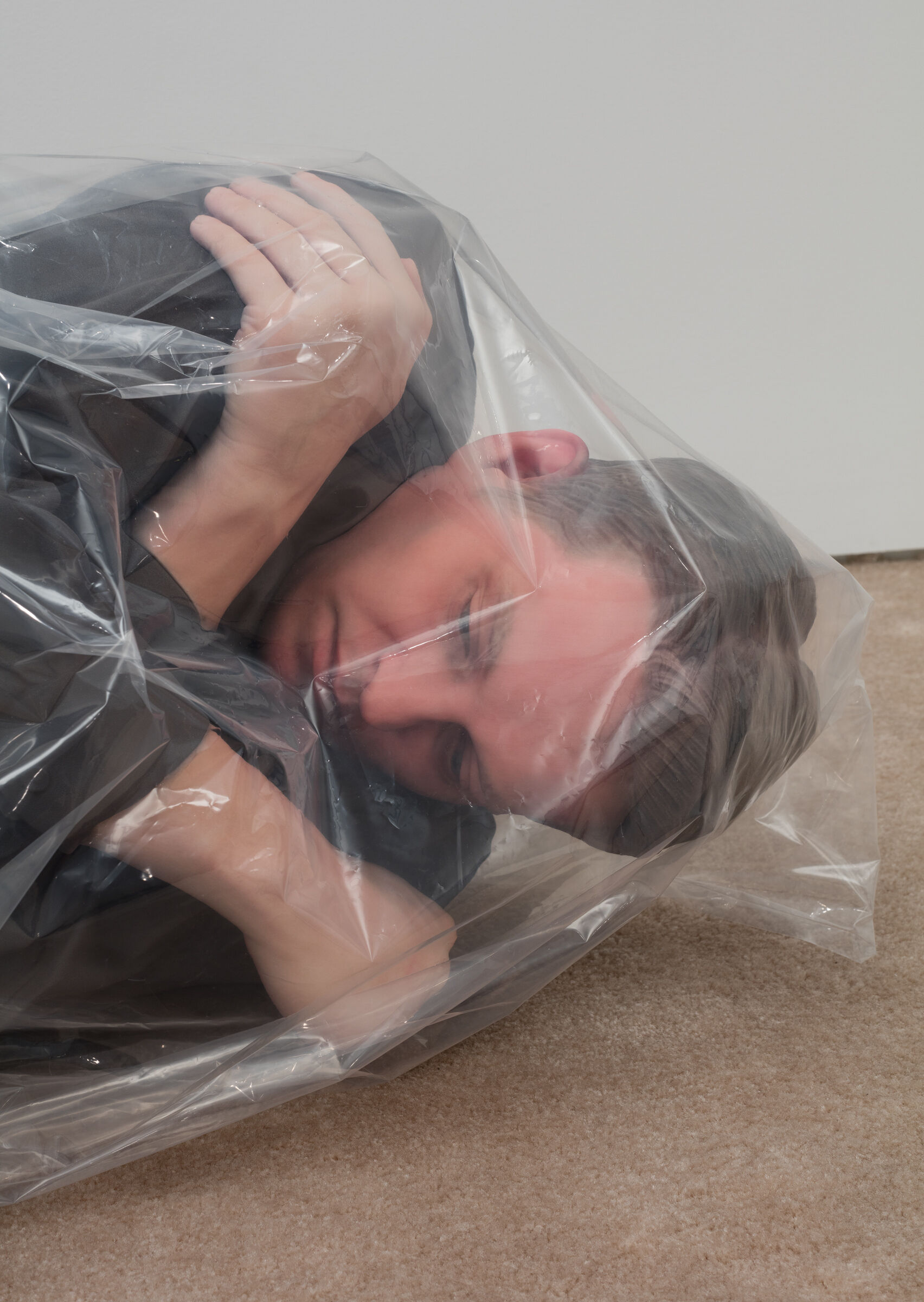
Josh Kline, Productivity Gains (Brandon/Accountant), 2016. 3D-printed plaster, inkjet ink, and cyanoacrylate; CNC-carved urethane foam with shellac-based color sealer; museum wax; and polyethylene bag, 21 1/2 x 27 x 55 in. (54.6 x 68.6 x 139.7 cm). Collection of the Carmel Barasch Family. © Josh Kline. Photograph by Joerg Lohse; image courtesy the artist and 47 Canal, New York

On a beige carpet, the viewer encounters a group of internally illuminated shopping carts filled with bottles shaped like human hands and flesh-toned coffee cups, keyboards, and office equipment. As one moves around the carts, recumbent life-size figures come into view, curled in the fetal position and wrapped in clear plastic. These sculptural portraits depict actual office workers who were unemployed at the time Kline was making the work. With the help of a casting agent, he hired them for 3D-scanning sessions, the results of which were then rendered through a combination of 3D-printing and CNC routing. The works are deeply uncanny, lifelike down to the texture of hair and skin, depicting people as mere surplus, packaged and made dormant by so-called technological disruption.
In the Unemployment installation, Kline is not only addressing the human cost of innovation thematically but also via the use of up-to-date technologies. Highly attuned to the choice of materials and methods of production—and with a regular nod to Marshall McLuhan’s famous axiom “The medium is the message”—Kline frequently uses new fabrication processes to critique the social repercussions of automation, taking up such technologies not for their novelty but in order to speak about their very nature. By presenting the potential repercussions of emerging technologies, he suggests the future is not predestined, that everyone deserves a say in how and what innovations should be implemented and at what cost.
The unsettling bagged bodies in Unemployment are not meant to mock those who will be disposed of in the next wave of technological revolution. Rather, the installation seeks to put a human face on the potential fallout. It is people like the actual Matthew and Joann—the unemployed mortgage loan officer and lawyer, who are portrayed in the installation—who should help decide how technology is used, not billionaire moguls like Jeff Bezos and Elon Musk. “As an artist who’s thinking about the consequences of technological innovation,” Kline has said, “I think there’s an obligation to raise questions about who benefits.”Josh Kline, quoted in Domenick Ammirati, “Focus Interview: Josh Kline,” Frieze, no. 157 (September 2013), 121.
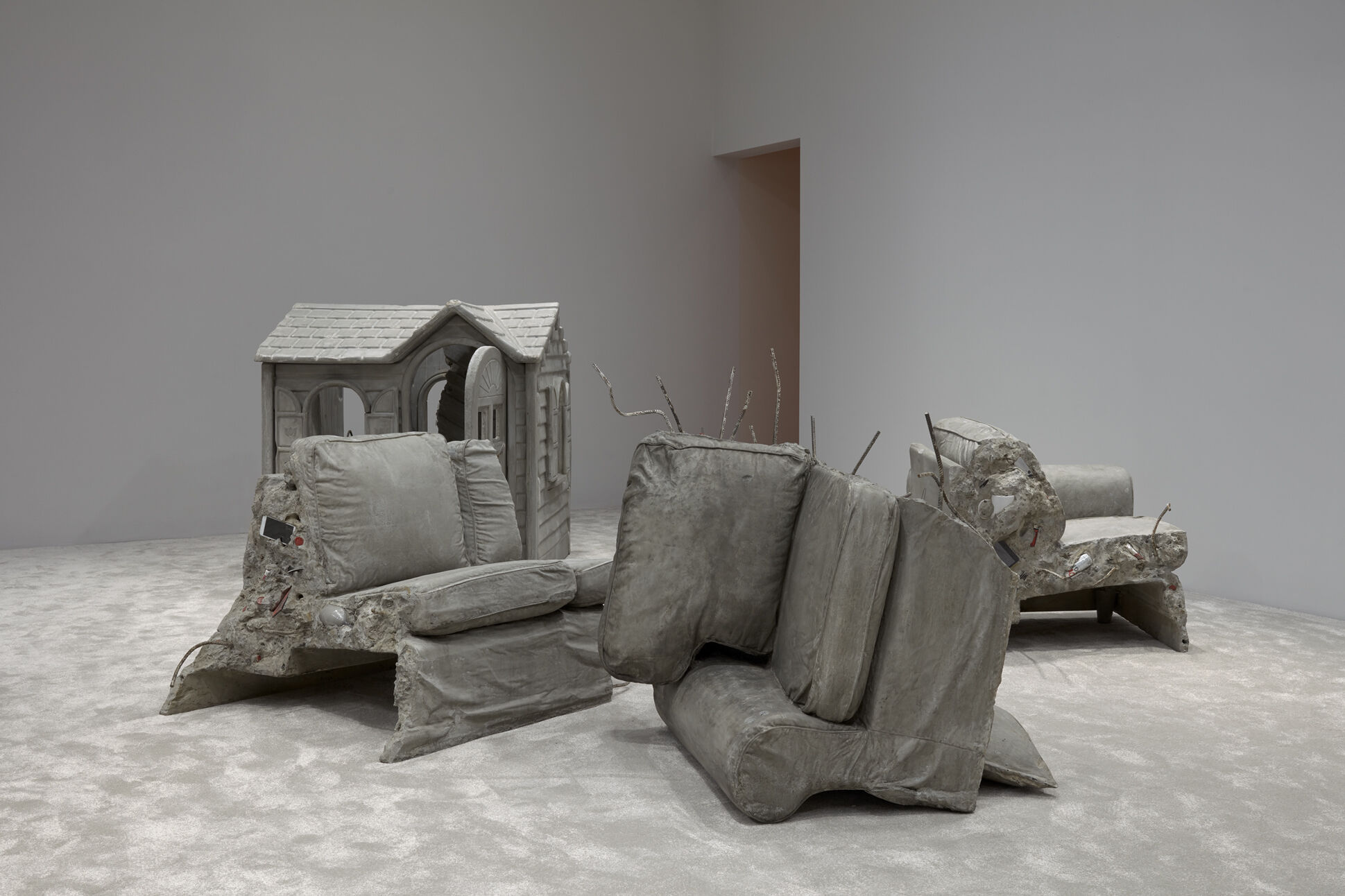
Josh Kline, Normalization, 2017. Casts in polymerized gypsum mixed with sand and gravel, urethane foam, rebar, acrylic, and mixed media, three parts: 46 x 38 x 39 in. (116.8 x 96.5 x 99.1 cm), 49 x 34 x 31 in. (124.5 x 86.4 x 78.8 cm), 51 x 37 x 31 in. (129.5 x 93.9 x 78.4 cm). Rubell Museum, Miami. © Josh Kline. Photograph by Robert Glowacki; image courtesy the artist and Modern Art, London

Grievances around who benefits lie at the heart of Kline’s related Civil War (2017) installation, which is the third chapter of this cycle. Also set in the 2030s, it imagines a nation riven by war caused by class division. In one room of the installation—which also includes spliced-together domestic appliances and a three-channel video—viewers encounter what feels like the aftermath of conflict, rubble in a consistent monochrome gray material made to mimic concrete. Children’s toys and car parts are piled in mounds; an expensive bathtub and a couch are split apart with rebar protruding. In the press release he wrote for the exhibition, Kline states, “Mass unemployment and extreme income inequality in a nation with no safety nets leads to civil disintegration. Democracy becomes brittle when enough people in a population get desperate.”Josh Kline, “Josh Kline: Civil War,” press release, Modern Art, London, October 2017.
By casting symbols of the middle class in what resembles cement, Kline strips the life away from them. Devoid of color and rendered in a homogenous gray, the works evoke the unsung struggle to maintain a middle-class existence, a brand of exhaustion rendered with a matte finish. Secreted within some of the objects are the detritus of consumer society—plastic utensils, bags of potato chips, old smartphones; the hidden trash obscured by middle-American domesticity.
When Kline began conceiving Civil War in spring 2016, in reaction to Donald Trump’s campaign for the presidency as well as larger currents of rising right-wing nationalism and widening social divisions, he had been thinking about the underlying factors feeding these schisms for some time. Inequality has been growing in the United States for decades, a rise that has coincided with the demographic shifts that have occurred within the Democratic Party starting in the 1970s. Once aligned with the working class, the party shifted its attention toward affluent, college-educated voters who live primarily in cities. Democrats abandoned their workingclass base, and by the 1990s had fully embraced those who might be considered “coastal elites.”
French economist Thomas Piketty writes, “The Democratic Party became the party of the educated in a country where the university system is highly stratified and inegalitarian and the disadvantaged have virtually no chance of gaining admission to the most selective colleges and universities.” He goes on, “If Democrats are now seen as serving the interests of the highly educated rather than the disadvantaged, it is above all because they never came up with an appropriate response to the conservative revolution of the 1980s.”Thomas Piketty, Capital and Ideology, trans. Arthur Goldhammer (Cambridge, MA: The Belknap Press of Harvard University, 2020), 833–34.
Through his work, Kline proposes another way to communicate with a broad public, embracing the visual vocabulary of mass culture and using it to sincerely promote radical left-wing politics. The confrontational tone of much of Kline’s work is intentional: he wishes to leave no ambiguity about the positions he is advocating. As critic Domenick Ammirati has written, “Kline is almost unique in stepping away from the lineage of Conceptual art by attempting to make works that are legible to a wide audience rather than a hermetic one.”Domenick Ammirati, “The Communicating Object,” in Josh Kline: Antibodies, exh. cat. (Oslo: Astrup Fearnley Museet, 2020), 30.In a long-form essay in progress that poses a rebuttal to the tenets of modernism, Kline describes a cultural split in which avant-garde movements since the middle of the twentieth century have focused on insular artistic concerns. However important those contributions were to art and the rest of culture, he argues, they fostered a hard social divide in terms of the audience for art. Art is not perceived as something for everyone. The barrier of entry is often too great for those who lack the time and resources to devote to its study.
As the rift widens between left and right, red states and blue states, the hermetic nature of much of modern and contemporary art echoes those divisions. Kline’s stepping away from movements like Conceptualism is an attempt to make art that does not merely speak to its own legacy, and to go beyond the insularity that is so entrenched in the art world. The sense of being disregarded feeds the deep splits visible today in American society as battles rage on numerous issues. Perhaps the climactic moment of this new culture war thus far, with rhetorical violence becoming literal, was the January 6, 2021, attack on the U.S. Capitol that attempted to stop the electoral vote count for the presidency won by Joe Biden. The “brittle” state of democracy of which Kline forewarned in his Civil War exhibition was palpable that day. It is not hard to imagine his bleak rubble as the final outcome on Capitol Hill had the insurrectionists had their way.
